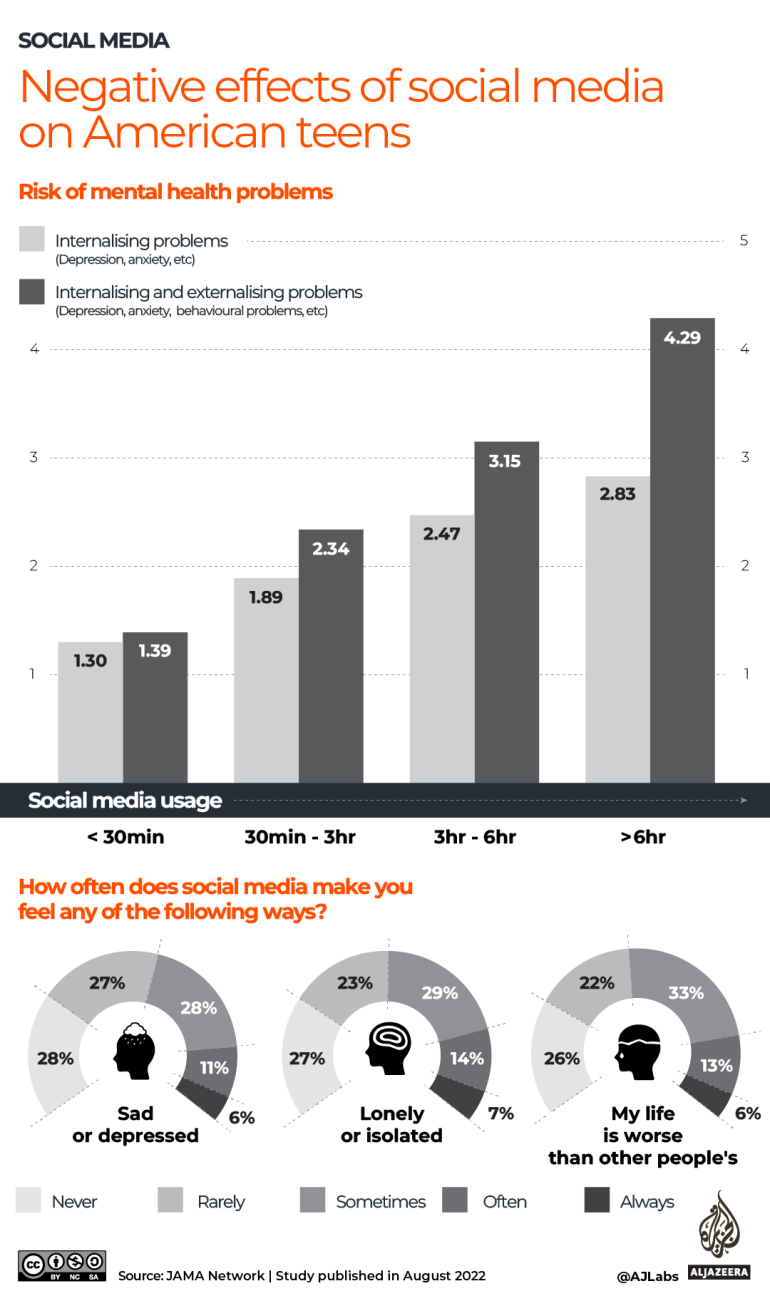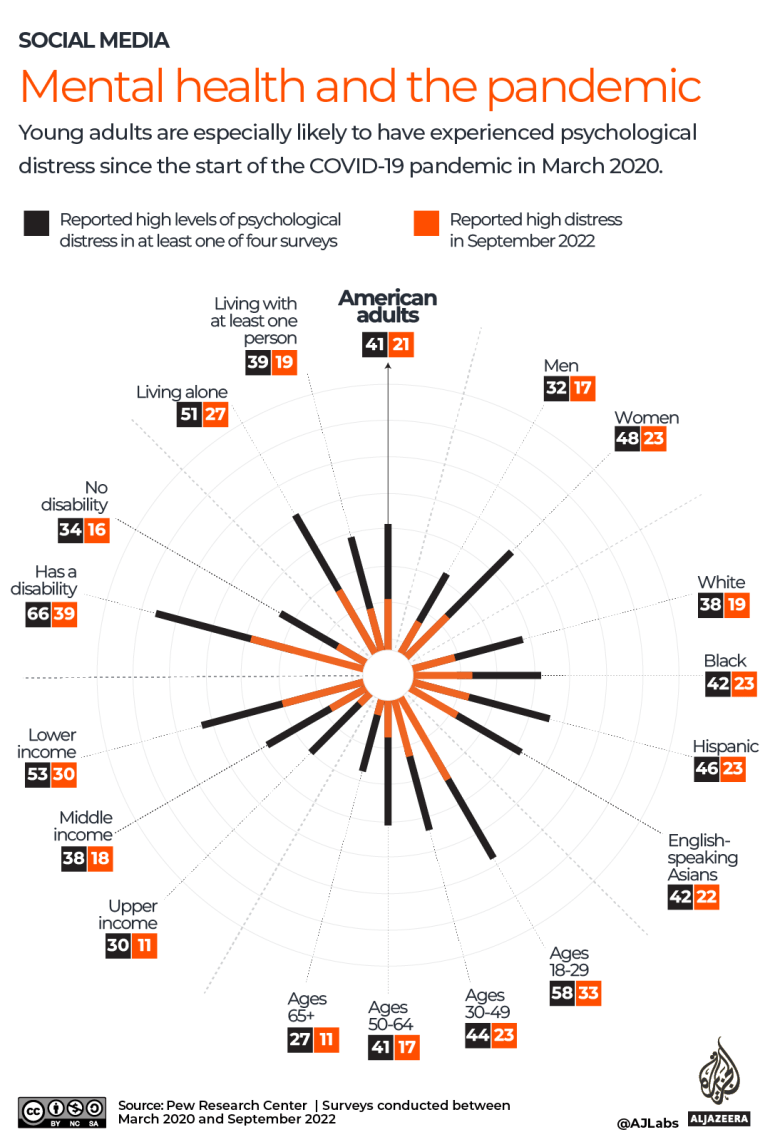The latest World Happiness Report, which is produced once a year by the Wellbeing Research Centre at the University of Oxford in the UK, shows that people under the age of 30 have experienced a dramatic decrease in happiness in recent years. Unhappiness is particularly pronounced in the US, which has dropped out of the index’s 20 happiest countries for the first time since 2012 when it was first published.
This year’s report, published last week, is the first to divide respondents by age but is only the latest to show that young people are struggling inordinately with mental distress.
What do the reports show?
Overall, reports are showing that mental health among young adults has declined sharply since the onset of the COVID-19 pandemic in March 2020, the effects of which are still taking a toll on the mental health of young people.
The 2023 State of Mental Health report from non-profit Mental Health America cited CDC figures showing that 67 percent of high school students had found school work more difficult during the pandemic, while 55 percent had experienced emotional abuse in the home during lockdowns. It added that 11 percent had experienced physical abuse and 24 percent said they did not have enough food to eat.
In addition, according to the US Census Bureau’s Household Pulse Survey, which surveyed adults from 2020 and 2022, there were higher levels of anxiety and depression among younger adults after surges of COVID-19 cases.
Pew Research, which undertook surveys across the general population from the start of the pandemic 2020 until September 2022, found that 58 percent of Americans aged 18 to 29 years old had experienced high levels of psychological distress – the highest of any age group.
More recently, the February 2024 Student Mental Health Landscape report by the publishing and research group Wiley, found that 80 percent of 2,500 college students surveyed in the US and Canada say they have experienced some degree of mental distress as a result of the pandemic – with anxiety, mental “burnout” and depression the most common conditions cited.

Which mental health disorders are young people suffering from?
In a recent interview, Admiral Dr Rachel Levine, the assistant secretary for health at the Department of Health and Human Services (HHS), said: “So we are looking at depression and anxiety, suicidality. We’re looking at eating disorders, we’re looking at the risk of substance use and the full range of mental health challenges that youth face.”
Common mental disorders among young adults can include depression, anxiety disorders, eating disorders such as bulimia nervosa and anorexia nervosa, body dysmorphia, attention deficit hyperactivity disorder (ADHD) and substance abuse.
Depression is the most common condition cited by young adults. According to a February 2023 Gallup survey undertaken across all 50 US states, young adults aged 18 to 29 are more likely to be diagnosed with depression than those older than 44.
Why are so many young people suffering from mental distress in the US?
There are many factors, however, some of the most commonly cited by young people suffering from mental distress are as follows:
Financial worries
The cost of university fees and the general cost of living are weighing heavily on the minds of young adults. In a 2022 Harvard study [PDF] of more than 1,800 people aged 18 to 25, more than half of respondents reported that financial worries (56 percent) were negatively impacting their mental health.
Similarly, in the Wiley study, close to half of students cited tuition fees (50 percent) and the cost of living (49 percent) as their biggest challenges.
The economic burden of undertaking university study has steadily grown over the past few decades. According to the National Center for Education Statistics (NCES), between the academic year of 1979-1980 and the academic year of 2021-2022, the cost of going to college increased by 136 percent, even after inflation is accounted for. This means that in real terms, the cost of going to college is more than twice as expensive now than it was 40 years ago. The biggest cost rise has been in tuition fees, which have increased by 170 percent over the past 40 years.
Loneliness
Feelings of isolation and loneliness were also cited by respondents to the Wiley study. In the Harvard study, 44 percent of young adults reported a sense of “not mattering to others” while 34 percent reported “loneliness”.
According to a 2023 Gallup poll, overall loneliness has decreased since early 2021, but young adults and those in lower-income homes are more likely to feel lonely than other age groups.
Some experts attribute this to the rise in social media use which has caused “virtual isolation” – or social isolation due to the use of mobile devices.
In May 2023, US Surgeon General Vivek H Murthy issued a report about the effects of social media on mental health, which stated: “Loneliness is far more than just a bad feeling – it harms both individual and societal health. It is associated with a greater risk of cardiovascular disease, dementia, stroke, depression, anxiety, and premature death.”
“Loneliness is the subjective feeling that you’re lacking the social connections you need. It can feel like being stranded, abandoned, or cut off from the people with whom you belong – even if you’re surrounded by other people. What’s missing when you’re lonely is the feeling of closeness, trust, and the affection of genuine friends, loved ones, and community,” Dr Murthy wrote in his 2020 book, Together: Why Social Connection Holds the Key to Better Health, Higher Performance, and Greater Happiness.

Social issues
In the 2022 Harvard study, 42 percent of respondents reported that gun violence in schools had a negative influence on their mental health, while 34 percent said they were worried about climate change and 30 percent expressed concerns about corruption among political leaders.
According to a 2018 survey conducted by the Harris Poll for the American Psychological Association, 75 percent of those aged between 15 and 21 reported that mass shootings were a considerable source of stress.
How can we solve this crisis?
There remain significant challenges to addressing mental distress among young adults, especially in the US.
Jan-Emmanuel De Neve, director of the Wellbeing Research Center and editor of the World Happiness Report, said: “To think that in some parts of the world children are already experiencing the equivalent of a midlife crisis, demands immediate policy action.”
Experts say helping young people build better relationships, giving them a sense of purpose and fostering a healthy environment that helps them achieve their future goals is the way forward.
What does seem clear, say campaigners, is that the emotional plight of so many young people demands far more concerted and serious attention from governments, colleges and universities, workplaces and many other institutions.
